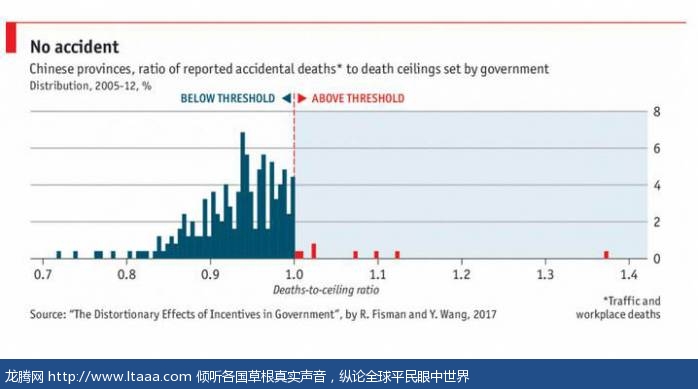经济学人:中国的道路和工作场所似乎变得越来越安全 [英国媒体]
图表显示的是2005-2012年间中国省份死亡人数达标情况的统计。横轴是死亡人数与政府限定最高值的比例,超过1.0即为不合格。纵轴是省份数量,2相当于5个省,4相当于10个省,以此类推。由于是8年的数值,所以每个省份一共被统计了8次,样本数量是中国省份数*8。
Daily chart
每日图表
China’s roads and workplaces seem to be getting less lethal
中国的道路和工作场所似乎变得越来越安全
图表显示的是2005-2012年间中国省份死亡人数达标情况的统计。横轴是死亡人数与政府限定最高值的比例,超过1.0即为不合格。纵轴是省份数量,2相当于5个省,4相当于10个省,以此类推。由于是8年的数值,所以每个省份一共被统计了8次,样本数量是中国省份数*8。
GOING by the numbers, China’s notoriously hazardous coal mines have become less perilous in recent years. InJanuary the government said that 538 people had died in mining accidents in 2016, a mere 11% of the death toll a decade earlier. The total number of deathsper million tonnes of coal extracted was the lowest ever. For Chinese industry generally, safety data are improving. In 2002 140,000 people died inwork-related accidents; last year the toll was less than one-third as high. On roads there has been similar progress: 58,000 deaths in 2015, down from 107,000in 2004. Officials admit the statistics remain “grim”, but their efforts to improve safety are apparently paying off.
从数字来看,中国臭名昭着的危险煤矿近几年正变得不那么危险。2017年1月,中国政府称2016年共有538人死于矿难,仅仅相当于10年前死亡人数的11%。每采挖百万吨煤死亡人数创下历史新低。中国工业的安全数据也正在普遍改善。在2002年,逾14万人死于工伤事故;而去年,这一数字不足2002年的三分之一。在道路安全上也有相似的进步:2015年死亡5.8万人,比2004年的10.7万人有所下降。官方承认统计表明形势依然“严峻”,但他们改善安全的努力显然卓有成效。
Perhaps, but the numbers should be treated with caution. In a forthcoming paper, Raymond Fisman of Boston University and Yongxiang Wang of the University of Southern California analyse a government campaign launched in 2004 to reduce accidental deaths at work andon roads. It set annual ceilings for such fatalities, nationally and locally.Officials would be punished if targets were exceeded.
或许改善是真的吧,但是这些数字应该被谨慎看待。在一篇即将发表的论文中,波士顿大学的雷蒙德·费思曼和南加州大学的王永祥(音)分析了中国政府2004年发起的旨在减少工伤及道路事故死亡人数的运动。它给国家和地方都设置了年度死亡上限。如果超出了这个限定值,相关官员就将受到惩罚。
To see how the policy has worked,Mr Fisman and Mr Wang calculated the deaths-to-ceiling ratio (reported deaths divided by the mandated ceiling) for each province. Most provinces would be expected to be close to the target, with some slightly above and some slightly below.But almost all the ratios the scholars calculated were shy of 1 (see chart),with an abrupt fall-off in numbers once the ceiling is surpassed. This suggests fiddling: the cliff-edge looks suspicious, and it is highly unlikely that the government set the ceilings generously high. Safety standards, the authorsconclude, have not improved as much as the numbers seem to show.
为了了解政策的实施效果,费思曼和王计算了每个省的死亡与限额之比(报告的死亡人数除以规定的最高限额)。大多数省份都接近限定值,有一些微微超出了一点,一些稍稍低一点。但两人计算得到的几乎所有比率都低于1(见图表),一旦超过上限,省份数量便骤降。这暗示着暗箱操作:限定值附近看起来很可疑,而且政府几乎不可能把限定值定得很宽松。作者总结道,安全标准并没有数据显示的那样提升得那么多。
版权声明
我们致力于传递世界各地老百姓最真实、最直接、最详尽的对中国的看法
【版权与免责声明】如发现内容存在版权问题,烦请提供相关信息发邮件,
我们将及时沟通与处理。本站内容除非来源注明五毛网,否则均为网友转载,涉及言论、版权与本站无关。
本文仅代表作者观点,不代表本站立场。
本文来自网络,如有侵权及时联系本网站。
图文文章RECOMMEND
热门文章HOT NEWS
-
1
最近,新冠肺炎疫情在日本有扩大的趋势,有专家呼吁日本应当举国行动起来,共...
- 2
- 3
- 4
- 5
- 6
- 7
- 8
- 9
- 10
推荐文章HOT NEWS
-
1
最近,新冠肺炎疫情在日本有扩大的趋势,有专家呼吁日本应当举国行动起来,共...
- 2
- 3
- 4
- 5
- 6
- 7
- 8
- 9
- 10











